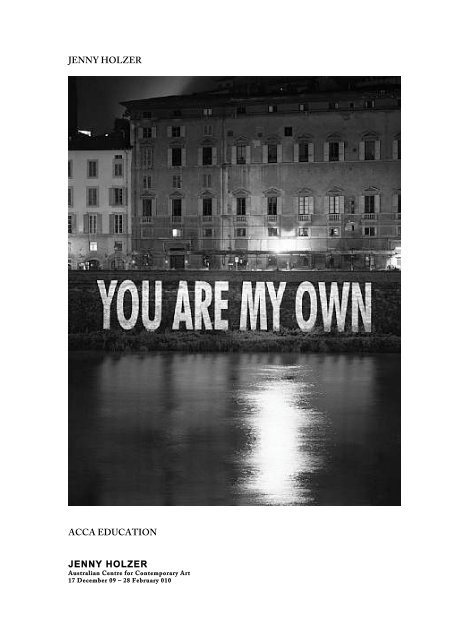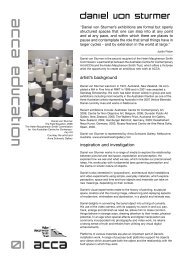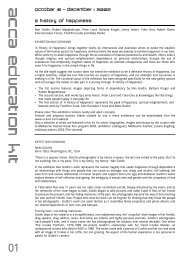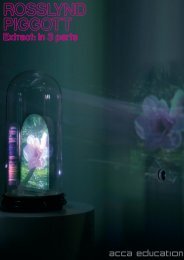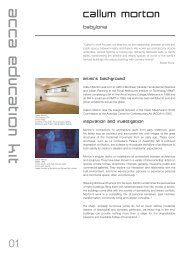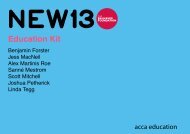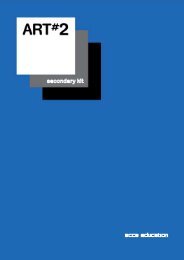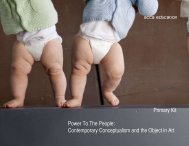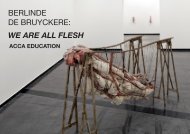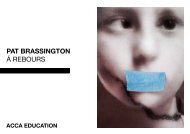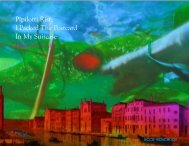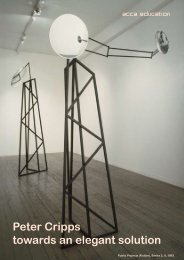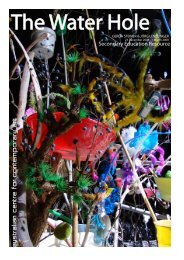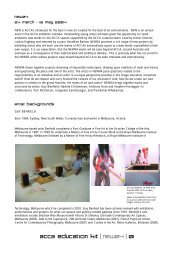JENNY HOLZER ACCA EDUCATION JENNY HOLZER
JENNY HOLZER ACCA EDUCATION JENNY HOLZER
JENNY HOLZER ACCA EDUCATION JENNY HOLZER
- No tags were found...
You also want an ePaper? Increase the reach of your titles
YUMPU automatically turns print PDFs into web optimized ePapers that Google loves.
Jenny Holzer – Artist BackgroundAmerican conceptual artist Jenny Holzer was born in Ohio in 1950 and has beenworking on her practice for over 30 years. She attended Ohio University, RhodeIsland School of Design and the Whitney Museum of American Art where shegraduated with a MFA in 1977. Originally working in abstraction in painting andprintmaking, her move to New York in 1977 influenced a change to moreconceptual, text-based art, in an attempt to infiltrate public spaces, beginningwith a series of posters distributed around New York.Holzer’s “Truism” series were posters of text containing bold and provocativestatements. They interrogated the spread of consumer imagery and itsdominance in the cityscape, and created a new forum for political intervention.Best known for this series, which she went on to print on golf-balls, mugs,bumper stickers, T-shirts and other objects. The series developed into large-scalelight projections onto buildings, landscapes, rivers and oceans throughout Europeand in America. Holzer’s truisms contained a number of contradictory,anonymous texts. Located in public places they force the spectator to considerwhat was being stated, the neutrality and anonymity of the style of the textencouraged the viewer to take their own stance and have a personal response tothe text which was often political, aggressive or intriguing.Jenny Holzer’s text works in public spaces communicate ideas of human fallibilityand situational ethics, encouraging an often strong reaction in the viewer in anattempt to evoke self-reflection and to express her own empathy with regards tohuman suffering and injustice. Over time Holzer’s public statements began toappear in galleries and international exhibitions, including the Venice Biennale,where in 1990 she was the first woman to represent America. They have alsobeen shown in the Reichstag, and the Guggenheim Museums in New York andBilbao.Holzer’s installation at <strong>ACCA</strong> includes significant works created in the last fiveyears and consists of light projections, recent paintings based on classified U.S
government documents, and an electronic LED sculpture. Holzer’s work wasinspired by a desire to find out more about the political situation in the middleeast and has drawn from US government documents, autopsy reports and soldierstatements the artist gained access to online through the ACLU and the Nationalarchives. The information she collated gives graphic and disturbing evidence ofthe maltreatment of Iraqi and Afghanistan soldiers at the hands of Americansoldiers, in particular the war crimes committed by these soldiers at Abu-Ghraibprison. Holzer presents painted screen prints of direct excerpts of soldierstatements as well as autopsy reports and handprints of the deceased in a factualand clinical way. The scale and use of painting, as well as the bright lights andtext of ‘Torso’ lure the audience into the space, in which they are forced tocontemplate and consider the issues and ideas presented.Ideas and InspirationJenny Holzer originally worked as a painter and printmaker during her time as astudent. Whilst studying at the Rhode Island Institute, Holzer copied diagramsfrom textbooks and found herself drawn to the captions beneath the images.Holzer liked the “neutral, factual and anonymous” nature of the text and thisinspired her change from painting to text work, which has been present in all ofher works made since this time. Holzer moved to New York in the late 1970’s.The urban landscape, in particular the bombardment of text displayed onbillboards, lights and advertising inspired her to add her own text (“truisms”) tothis landscape. Beginning by sticking small posters with text onto walls andwindows in lower Manhattan, her work developed and she began making workwith text displayed on mugs, golf balls, bumper stickers, t-shirts and otherobjects. Eventually projecting text through light onto buildings, rivers and oceans.Holzer’s change from more traditional methods of art making was also inspired byconceptual artists such as Joseph Kosuth who believed art should be a rejectionof formalism and rather a continuation of philosophy.Holzer also drew influence from her experience as a student at the WhitneyMuseum of American Art, where she felt painting was discouraged. Her instructorRon Clarke encouraged her to read about a variety of theorists and artistsincluding Bertolt Brecht to Jaques Derrida. Weekly guest speakers included suchconceptual artists as Vito Acconci, Dan Graham and Alice Neel. These directlyinspired her “Truisms” series.Holzer is influenced by political issues in many of her works. Works such as‘Lustmord’ comment on the treatment of female victims of war during the war informer Yugoslavia and her ‘Redaction prints’ in which she uses US armydocuments containing information about the mistreatment of Afghan and Iraqicivilians at the hands of American soldiers.
Materials and TechniquesJenny Holzer was initially an abstract painter, drawing influence from artists suchas Mark Rothko and Morris Louis. Whilst studying design at the Rhode IslandInstitute in the 1970’s Holzer copied diagrams of designs from books. During thisexercise she became more interested in the captions beneath these images, shewas drawn to the factual, anonymous and neutrality of the words. This becamethe beginning of a 30-year career in predominantly text-based works. In the late1970’s Holzer created a series coloured sheets of paper with typed sentences onthem that she stuck to wall and windows in lower Manhattan secretly during thenight. Holzer’s ‘Truisms’ series contained bold, sometimes aggressive,contradictory, intriguing statements. Her intention was to cover as many topicsas possible from many differing viewpoints. Her style of writing is deliberately unemotive.She presents the audience with statements where the author is hidden,it is gender neutral. The contrary opinions also hide any stance of the author.Holzer began to print these “truisms” on caps, t-shirts, mugs, golf-balls andeventually projected them onto landscapes, buildings, lakes and rivers all overthe world. The billboards and light signs that filled the streets of NYE inspiredHolzers change to the use of LED (Light-emitting diode) signs to project her“Truisms” onto buildings and landscapes. Holzers most recent works have beenmade with LCD (Liquid crystal display) both technologies enabled allowed Holzerto reach a larger audience. Holzer likes to make pieces to fit the site in whichthey are installed.Text based art - Language as ArtHolzer’s text based works began as a series of posters of “truisms” containinglists of typed statements, in alphabetical order, she posted at night on buildingsin lower Manhattan. Inspired by the text she saw already dominating thelandscape of New York she wanted to create work that would stir people out oftheir complacency by creating statements that were bold, aggressive anddisplayed contradictory viewpoints. Holzer’s text was deliberately neutral andanonymous in an attempt to evoke a response in the viewer and allow them totake their own stance on the issues and ideas presented. Holzer has for much ofher practice been interested in the power of text based art. Her interest is in howtext addresses its audience in confronting ways, whilst at the same time can bemuch more accessible than painting, stating, “people can struggle and feelintimidated by painting, but language is something they access immediately”Holzer’s text works often address difficult subjects such as injustice, political andsexual violence, death, grief and rage. As well as exploring these broad andpolitical themes her works also express the intimate and personal. Holzeroriginally created her own statements, but has altered this style in the pastdecade, borrowing text from poets, politicians, and anonymous people of statesecurity forces. Holzer has presented these text works using light projection,carved words into marble benches and seats, written in red ink and blood ontoflesh, and printed words onto objects and clothing. In many of her works there isa tension in the statements she presents. Statements such as “Ruin Yourselfbefore they ruin you” and “Lack of charisma can be fatal” evoke enquiry and aresponse. Ambiguous statements such as “money creates taste” and “eating toomuch is criminal” challenge the viewer’s passivity and draw them into the issueshe is presenting. Holzer states that her work “takes you in and out of advocacy,through bad sex, murder, paralysis, poor government, lunacy and aimlessness…
(she) hope (s)..that (her) work is useful” By the use of text on objects such asbumper stickers, T-shirts, mugs, posters and caps, she brings her concepts intoour everyday lives and make us think about the significance of the text we areexposed to daily.Holzer adapted to technological advances with her change to large light projectedtexts that were displayed in interior spaces as well as on buildings and landscapesin various locations around the world. She also began to draw on text fromexternal sources, rather than text she created, such as poets, friends andgovernment documents found online.Projected WorksSince 1996 Jenny Holzer has used architecture and landscape as the screens forher text works to be projected onto. Linking her earlier street-based practice toher continuous engagement with media and advertising tactics, Holzersprojections have enabled her to reach and engage with new audiences and havetaken place in five continents, over a dozen countries and nearly thirty cities.Holzer first displayed her projected texts in the interior of the MAK in Vienna.Here she used two projectors facing each other to create an immersive space inwhich words overlapped in a space flooded with white light and language.Holzer has projected texts both in interior and exterior spaces as well as urbanand rural settings, showing her own words and those borrowed from others.“I show what I can with words in light and motion in a chosen place, and when Ienvelop the time needed, the space around, the noise, smells, the people lookingat one another and everything before them, I have given what I know”drawn from poets, such as the Polish Nobel Laureate, Wislawa Szymborska, andhas used quotes from politicians, friends and other anonymous sources.
Political Works and Themesfrom Lustmord, collaborationwith Tibor Kalman1993-94Photographs of handwriting in ink on skin32 x 22cm each pageProject for ‘Suddeutsche ZeitungMagazine, No. 46, 1993 Collection,Centre for Curatorial Studies,Bard College, Annandale-on-Hudson,New YorkIn many of her works Jenny Holzer explores political themes, in particular abusesof power and atrocities of war. In her series ‘Lustmord’ (1993-94) – meaningrape murder in German – Holzer created a number of works addressing warcrimes in the former Yugoslavia in the 1990’s, in particular the violent physicalabuse, rape and murder of women that occurred. In this series Holzer displaysphotographs of text on human skin, some of which includes women’s blood mixedwith ink.Holzer often creates tension by conveying bold statements and the use ofcontradictory terms and viewpoints. She deals with the public and the private,fact and fiction, the universal and the particular, and the body, including bodypolitics. In ‘PROTECT PROTECT’, for example, Lustmord Table (1994) alsoreferences torture and bodily harm. In this work Holzer displays human boneswith silver bands impressed with words by rape victims, perpetrators andwitnesses.Holzer has also explored the more recent war in Iraq and America’s involvementand presence in The Middle East. Over five years Holzer looked at 40,000documents online including autopsy reports, police memos, and statements by USsoldiers. Holzer claimed she was confused by the motivation of the Americangovernments involvement in the war. This inspired her to research online togather more information. Since 2004 she has used text from declassifiedgovernment documents, the earliest about Reagan’s support of Sadam Hussein inthe 1980’s. Holzer obtained much of the classified information she used as a
esult of the 1966 freedom of information act. In her political works Holzer drawson the national Security archives collection, old material from the FBI’s website,postings by the ACLU (American Civil Liberties Union) and a number of otherplaces. She is constantly searching for material. As well as focusing ondocuments about the conflict in the Middle East and the gulf war, Holzer has alsogone back to older things for comic relief, such as the FBI following aroundAmerican painter and alleged Communist, Alice Neal.Many of Holzers work focus on unnecessary cruelty. She wants people to reactand recoil. Holzer would like there to be less fear and cruelty in the world and herwork is an expression of her empathy with human suffering and injustice. She isalso exploring human fallibility, situational ethics and self-reflection, whilst oftenfocusing on universal questions.Jenny Holzer’s “Lustmord Table” (1994) at Cheim & Reid.
WORKS IN <strong>ACCA</strong> EXHIBITIONPROJECTIONSJenny Holzer’s large-scale light work, Projections displays a number of poems byPolish Nobel Prize winner Wislawa Szymborska. Szymborska, similarly to Holzer,explores political and moral issues in her poetry and often uses contradiction, anddifferent viewpoints and perspectives to explore ideas.The work is projected using a large light projector, created specifically for thescale of the text.The repetition of the text and the speed at which it is displayed across the floor,ceiling and walls creates an immersive environment where the viewer feels theyhave little control over what is happening, with the word seeming to shout at theviewer despite the fact that the room is silent. This feeling of lack of controlcombined with the repetition of the text and the dimly lit space reference thetorture techniques displayed in her other political works.Holzer has included with this work four beanbags for viewers to sit on as theyread the text. The fabric has come from NASA and is heat sensitive, allowingviewers to create handprint marks onto the fabric. Linking these handprints to thepaintings she presents of handprints of both US soldiers and detainees Holzerreminds us that we make an imprint and how we live has an impact on thosearound us.Holzer’s light projected work is one of the many she has created in this style.With her past works taking place in four continents, fourteen countries, and morethan thirty cities including Florence, Rome, Rio de Janeiro, Venice, Oslo, BuenosAires, Berlin, Paris, Singapore, San Diego, and New York City. From Mies van derRohe’s Neue Nationalgalerie in Berlin and I.M. Pei’s Pyramide du Louvre in Paris,to the New York Public Library and Rockefeller Center in New York.Jenny HolzerPROJECTIONS, 2008Light projectionMassachusetts Museum of Contemporary Art (MASS MoCA),North Adams, Massachusetts, USAText (pictured): “Parting with a View” from View with a Grain ofSand by Wisawa Szymborska, copyright © 1993 by the author.English translation by Stanisaw Baraczak and Clare Cavanagh,copyright © 1995 by Harcourt, Inc.Used/reprinted with permission of the author.© [2009] Jenny Holzer, member Artists RightsSociety (ARS), NY.Photo: Attilio Maranzano
REDACTION PAINTINGSFirst exhibited in 2006, the Redaction Paintings are a series of works thatincorporate declassified and other sensitive texts from US government documentsrelating to the Middle East conflicts. HAND (2008), is a group of paintings thatform a tableau comprised of images of the hand prints of American soldiersaccused of crimes in Iraq. The handprints themselves have been redacted toefface individuating marks. Holzers handprints of the deceased are her apologiesto the dead for their mistreatment and in some cases, subsequent murder at thehands of American soldiers. She has presented them as screen-prints in oil oncanvas increasing them from their original document size to that of themonumental, the handprints of the perpetrating American soldiers and theabused detainees hanging side by side in memoriam. Despite her source materialHolzer does not offer an easy ideological reading. This is the hazy netherworld ofmilitary combat where the murky is perpetrated in the name of "nationalsecurity" and "democracy". Hanging the hands of the charged next to those foundto be wrongly accused and those whose culpability has been lost, the artistrepresents the fog of war.Jenny Holzer, Left Hand (Palm Rolled), 2007,Oil on linen, 80 x 62 in. (203.2 x 157.5 cm),Text: U.S. government document,© 2009 Jenny Holzer, member Artists Rights Society (ARS), NY;Collection of the artist; courtesy Cheim & Read, New York; Monika Sprüth Philomene Magers,Berlin and London; and Yvon Lambert, Paris
A series of canvases detail email exchanges between U.S Army personnel inwhich they discuss what they call “alternative interrogation techniques” for“unlawful; combatants”. Low-level voltage electric shocks and muscle fatigueinducement are described as “coercive techniques that may be employed (but)cause no permanent harm”. These documents were declassified under freedom ofinformation legislation whilst US press reported such abuses weren’t taking placeat the time. By appropriating found documents, Holzer bears witness to ourrecurrent and recent historical reality. In this regard the works can be seen to actas history paintings.Torso200710 double-sided, curved electronic LEDsigns with red and blue diodes on front andblue and white diodes on backText: US government documents219.2 x 146.8 x 73.4 cm(86.3 x 57.8 x 28.9 in)Courtesy the Artist, Spruth Magers BerlinLondon, and Galerie Nikolaus RuzicskaSalzburg
Resembling an abstracted human rib cage Holzer’s LED installation Torso, stacksten semi-circular signs that display in a bruised palette of red, blue, white, andpurple light the statements, investigation reports, and emails from case files ofsoldiers accused of various crimes in the Middle East. Providing these voices, partdamning, contradictory, sympathetic, anecdotal, and evidentiary, Holzer layersaccounts of abuse and blame. The documents selected by the artist do not recordspectacular images of war but rather absurd, horrifying details. Holzer poses thequestion, do we need to see brutal violence before anything is done about it? Canthe private body become enmeshed and lost in information and governmentoperations? Holzer said she started looking at these documents because shewanted to understand how and why “torture became normalized.”COMMENTARIESVictoria LautmanPosted: December 8, 2008 01:51 PMAt the Crossroads of Politics and Art, Jenny Holzer is waiting."Jenny's work isn't just about war per se, although it's a central theme," explainsElizabeth Smith, Chief Curator and Deputy Director for Programs at the M.C.A.,who organized the exhibition, on view until February 1st before traveling on toNew York and Europe. "But it's really about power, and the relationship betweenthe individual and society. She doesn't take a position, but presents theinformation in a way that works on the mind and the senses."“Still, it's not just the secret residue of war in Iraq that permeates the show, butthe details of humanity's very worst impulses through all manner of trauma,emotional and physical”-http://www.huffingtonpost.com/victoria-lautman/at-the-crossroads-ofpoli_b_148608.html“Jenny Holzer's pioneering approach to language as a carrier of content and heruse of nontraditional media and public settings as vehicles for that content makeher one of the most interesting and significant artists working today. Alternatingbetween fact and fiction, the public and the private, the universal and theparticular, Holzer's work offers an incisive social and psychological portrait of ourtimes.”-Whitney Museum of American Arthttp://www.whitney.org/www/holzer/index.jsp“the texts function as comments on that environment they fit into, stimulatingawareness of our social conditioning as conveyed by the very landscape in whichwe may be confronted by them.”http://adaweb.walkerart.org/context/artists/holzer/holzer1.html
“Whether questioning consumerist impulses, describing torture, or lamentingdeath and disease, Jenny Holzer’s use of language provokes a response in theviewer.”-http://www.pbs.org/art21/artists/holzer/index.htmlYou’ve talked about how you like your work to be socially useful. In youropinion, what are the more useful capacities art can serve today?A translation is that I want to be useful somehow to justify my existence. I don’tthink that art has to be useful, at least not in any straightforward way. I don’twant art in service. But good art can be responsive, alive to and so truthful aboutwhat’s around, and that’s potentially helpful. Being awestruck, dumbstruck andtransfixed by art can be dandy. And being aroused, stunned, terrified, lulled,intrigued, confounded, freed, schooled and euphoric is a lot, and art can do thatand more.http://www.nypress.com/article-19515-using-protection.htmlARTIST COMPARISONSCompare Jenny Holzer’s projected works to the work of Barbara Kruger. Selectone of Holzer’s truisms and compare this to one of Kruger’s statements. Discussboth these works.Look at artist Francisco Goya images of war and compare and contrast his workswith Jenny Holzers works regarding war in The Middle East.PUBLIC ART:Look at a range of artists who exhibit their work in public places. Look at thework of Claus Oldenberg (Clothespin), Robert Smithson (Tilt Shift) and Christo.Explore the public art of Melbourne. Look at the famous Bronze Men, the Bourkestreet purse and the Bird sculpture in the docklands. How does public art makean impact on our daily lives and the landscape of our city?Holzer’s work could be considered a more technologically advanced form ofgraffiti. Discuss the differences between what Holzer is doing and the work ofgraffiti artists you have seen in public locations in Melbourne.
VELS AND VCE CURRICULUM LINKSVCE MediaJenny Holzer’s statements encourage us to consider the slogans and statementsthat we see on a regular basis through the media.Consider the strategies that advertising companies use to manipulate us in ourpublic environment. Consider the use of scale, colour, content and location.Select one advertisement you have seen in a public space and analyze this workconsidering the above factors.Jenny Holzer was originally a painter but her work moved into painting text ontopaintings and then to text alone.Consider the ways art materials have changed with technology. Holzer hasadapted to working with materials we see in our daily lives in public places suchas lights and public installations.Do you think it is necessary for artists to work in postmodern art materials fortheir work to be relevant in 2009? Or is their still a place for more traditionalforms of art making such as painting, drawing and sculpture?Practical ArtworkYear 9 Art.Create and artwork using black and white text only, inspired by jenny Holzer’s‘Truisms’. Consider a statement you may like to make, it could be a political orpersonal statement, about politics, identity or any other issue.Year 7 EnglishConsider the use of text in art. Would you consider Holzer’s work to be poetrythat is displayed in public places? What do you think of the idea of poetry that isonly one line in length? In what person are the statements made?How does Holzer’s work challenge the media we see around us? Consider theway Holzer makes her audience think about the culture in which we live? Look atartists throughout history who have created works to challenge societal norms ortrends? Look at artists who have made works with content that has at that timemade viewers uncomfortable or challenged viewers?VCE EnglishWhat is the difference between statement and poetry? Is there a difference?What is a truism? Can you think of an example? Create your own truism.
VCE ArtAnalyze the works of Jenny Holzer using a Political Interpretive framework.Consider how Holzer references political conflict in the Middle East and discussthis. Compare her work to a range of other artists also exploring political issues intheir work.UNIT 3 ARTOutcome 1Use the Analytical Frameworks to analyze and interpret artworks produced before1970 and artworks produced since 1970, and compare and contrast the meaningsand messages of artworks produced before 1970 with those of artworks producedsince 1970.FRANCIS PICABIA (1879 – 1953)<strong>JENNY</strong> <strong>HOLZER</strong> (1950 - )http://www.arthistoryarchive.com/arthistory/contemporary/Jenny-Holzer.htmlUNIT 4 ARTOutcome 1Discuss and debate an art issue using selected artist/s works as context, andpresent their informed opinion with reference to artworks and with the support ofselected commentaries and relevant aspects of the Analytical Frameworks.BARBAR KRUGER (1945 - )http://www.arthistoryarchive.com/arthistory/feminist/Barbara-Kruger.htmlALEXANDER RODCHENKO (1891 – 1956)In this area of study, students must study:• a minimum of one selected art issue;• at least one artist not studied in Unit 3 and a minimum of two artworks by thatartist;• a range of diverse viewpoints as seen in commentaries relating to artworks andart issues.
TRUISMSa little knowledge can go a long waya lot of professionals are crackpotsa man can't know what it is to be a mothera name means a lot just by itselfa positive attitude means all the difference in the worlda relaxed man is not necessarily a better mana sense of timing is the mark of geniusa sincere effort is all you can aska single event can have infinitely many interpretationsa solid home base builds a sense of selfa strong sense of duty imprisons youabsolute submission can be a form of freedomabstraction is a type of decadenceabuse of power comes as no surpriseaction causes more trouble than thoughtalienation produces eccentrics or revolutionariesall things are delicately interconnectedambition is just as dangerous as complacencyambivalence can ruin your lifean elite is inevitableanger or hate can be a useful motivating forceanimalism is perfectly healthyany surplus is immoralanything is a legitimate area of investigationartificial desires are despoiling the earthat times inactivity is preferable to mindless functioningat times your unconsciousness is truer than your conscious mindautomation is deadlyawful punishment awaits really bad people
ad intentions can yield good resultsbeing alone with yourself is increasingly unpopularbeing happy is more important than anything elsebeing judgmental is a sign of lifebeing sure of yourself means you're a foolbelieving in rebirth is the same as admitting defeatboredom makes you do crazy thingscalm is more conductive to creativity than is anxietycategorizing fear is calmingchange is valuable when the oppressed become tyrantschasing the new is dangerous to societychildren are the most cruel of allchildren are the hope of the futureclass action is a nice idea with no substanceclass structure is as artificial as plasticconfusing yourself is a way to stay honestcrime against property is relatively unimportantdecadence can be an end in itselfdecency is a relative thingdependence can be a meal ticketdescription is more important than metaphordeviants are sacrificed to increase group solidaritydisgust is the appropriate response to most situationsdisorganization is a kind of anesthesiadon't place too much trust in expertsdrama often obscures the real issuesdreaming while awake is a frightening contradictiondying and coming back gives you considerable perspectivedying should be as easy as falling off a logeating too much is criminalelaboration is a form of pollution
emotional responses are as valuable as intellectual responsesenjoy yourself because you can't change anything anywayensure that your life stays in fluxeven your family can betray youevery achievement requires a sacrificeeveryone's work is equally importanteverything that's interesting is newexceptional people deserve special concessionsexpiring for love is beautiful but stupidexpressing anger is necessaryextreme behavior has its basis in pathological psychologyextreme self-consciousness leads to perversionfaithfulness is a social not a biological lawfake or real indifference is a powerful personal weaponfathers often use too much forcefear is the greatest incapacitatorfreedom is a luxury not a necessitygiving free rein to your emotions is an honest way to livego all out in romance and let the chips fall where they maygoing with the flow is soothing but riskygood deeds eventually are rewardedgovernment is a burden on the peoplegrass roots agitation is the only hopeguilt and self-laceration are indulgenceshabitual contempt doesn't reflect a finer sensibilityhiding your emotions is despicableholding back protects your vital energieshumanism is obsoletehumor is a releaseideals are replaced by conventional goals at a certain ageif you aren't political your personal life should be exemplary
if you can't leave your mark give upif you have many desires your life will be interestingif you live simply there is nothing to worry aboutignoring enemies is the best way to fightillness is a state of mindimposing order is man's vocation for chaos is hellin some instances it's better to die than to continueinheritance must be abolishedit can be helpful to keep going no matter whatit is heroic to try to stop timeit is man's fate to outsmart himselfit is a gift to the world not to have babiesit's better to be a good person than a famous personit's better to be lonely than to be with inferior peopleit's better to be naive than jadedit's better to study the living fact than to analyze historyit's crucial to have an active fantasy lifeit's good to give extra money to charityit's important to stay clean on all levelsit's just an accident that your parents are your parentsit's not good to hold too many absolutesit's not good to operate on creditit's vital to live in harmony with naturejust believing something can make it happenkeep something in reserve for emergencieskilling is unavoidable but nothing to be proud ofknowing yourself lets you understand othersknowledge should be advanced at all costslabor is a life-destroying activitylack of charisma can be fatalleisure time is a gigantic smoke screen
listen when your body talkslooking back is the first sign of aging and decayloving animals is a substitute activitylow expectations are good protectionmanual labor can be refreshing and wholesomemen are not monogamous by naturemoderation kills the spiritmoney creates tastemonomania is a prerequisite of successmorals are for little peoplemost people are not fit to rule themselvesmostly you should mind your own businessmothers shouldn't make too many sacrificesmuch was decided before you were bornmurder has its sexual sidemyth can make reality more intelligiblenoise can be hostilenothing upsets the balance of good and eviloccasionally principles are more valuable than peopleoffer very little information about yourselfoften you should act like you are sexlessold friends are better left in the pastopacity is an irresistible challengepain can be a very positive thingpeople are boring unless they are extremistspeople are nuts if they think they are importantpeople are responsible for what they do unless they are insanepeople who don't work with their hands are parasitespeople who go crazy are too sensitivepeople won't behave if they have nothing to losephysical culture is second best
planning for the future is escapismplaying it safe can cause a lot of damage in the long runpolitics is used for personal gainpotential counts for nothing until it's realizedprivate property created crimepursuing pleasure for the sake of pleasure will ruin youpush yourself to the limit as often as possibleraise boys and girls the same wayrandom mating is good for debunking sex mythsrechanneling destructive impulses is a sign of maturityrecluses always get weakredistributing wealth is imperativerelativity is no boon to mankindreligion causes as many problems as it solvesremember you always have freedom of choicerepetition is the best way to learnresolutions serve to ease our consciencerevolution begins with changes in the individualromantic love was invented to manipulate womenroutine is a link with the pastroutine small excesses are worse than then the occasional debauchsacrificing yourself for a bad cause is not a moral actsalvation can't be bought and soldself-awareness can be cripplingself-contempt can do more harm than goodselfishness is the most basic motivationselflessness is the highest achievementseparatism is the way to a new beginningsex differences are here to staysin is a means of social controlslipping into madness is good for the sake of comparison
sloppy thinking gets worse over timesolitude is enrichingsometimes science advances faster than it shouldsometimes things seem to happen of their own accordspending too much time on self-improvement is antisocialstarvation is nature's waystasis is a dream statesterilization is a weapon of the rulersstrong emotional attachment stems from basic insecuritystupid people shouldn't breedsurvival of the fittest applies to men and animalssymbols are more meaningful than things themselvestaking a strong stand publicizes the opposite positiontalking is used to hide one's inability to actteasing people sexually can have ugly consequencestechnology will make or break usthe cruelest disappointment is when you let yourself downthe desire to reproduce is a death wishthe family is living on borrowed timethe idea of revolution is an adolescent fantasythe idea of transcendence is used to obscure oppressionthe idiosyncratic has lost its authoritythe most profound things are inexpressiblethe mundane is to be cherishedthe new is nothing but a restatement of the oldthe only way to be pure is to stay by yourselfthe sum of your actions determines what you arethe unattainable is invariable attractivethe world operates according to discoverable lawsthere are too few immutable truths todaythere's nothing except what you sense
there's nothing redeeming in toilthinking too much can only cause problemsthreatening someone sexually is a horrible acttimidity is laughableto disagree presupposes moral integrityto volunteer is reactionarytorture is barbarictrading a life for a life is fair enoughtrue freedom is frightfulunique things must be the most valuableunquestioning love demonstrates largesse of spiritusing force to stop force is absurdviolence is permissible even desirable occasionallywar is a purification ritewe must make sacrifices to maintain our quality of lifewhen something terrible happens people wake upwishing things away is not effectivewith perseverance you can discover any truthwords tend to be inadequateworrying can help you prepareyou are a victim of the rules you live byyou are guileless in your dreamsyou are responsible for constituting the meaning of thingsyou are the past present and futureyou can live on through your descendantsyou can't expect people to be something they're notyou can't fool others if you're fooling yourselfyou don't know what's what until you support yourselfyou have to hurt others to be extraordinaryyou must be intimate with a token fewyou must disagree with authority figures
you must have one grand passionyou must know where you stop and the world beginsyou can understand someone of your sex onlyyou owe the world not the other way aroundyou should study as much as possibleyour actions are pointless if no one noticesyour oldest fears are the worst ones


